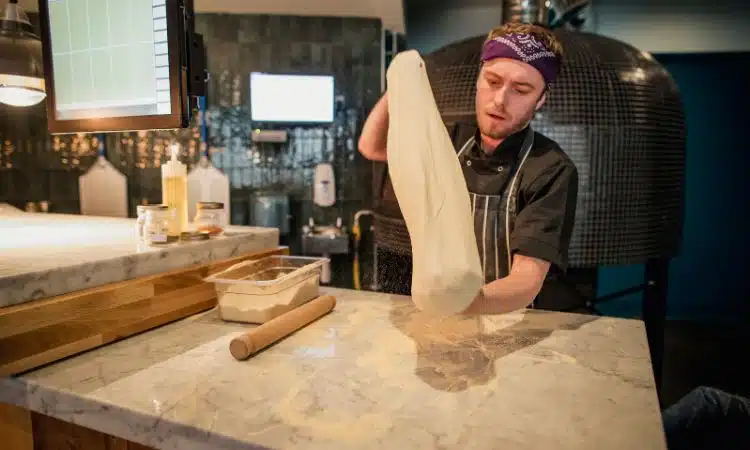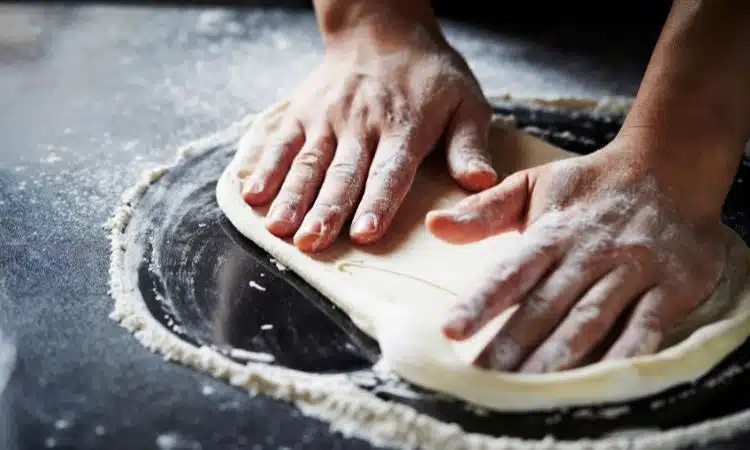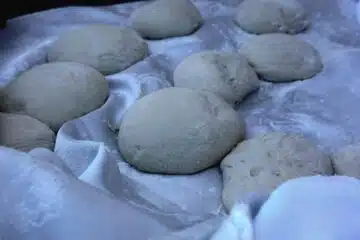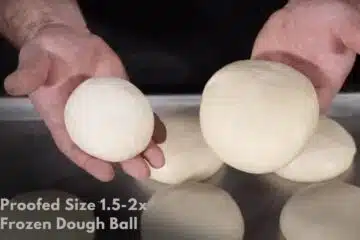Why Doesn’t Pizza Dough Stretch? Pizza dough will only stretch properly if it is overworked or too cold. It requires the right gluten development and resting time to become pliable.
Crafting the perfect pizza dough can sometimes feel like aiming for a moving target. The magic lies not just in the ingredients but also in the intricate dance of chemistry and physics. Gluten strands in the Dough need time to relax after the kneading process; without rest, they become tight and snap back when you try to stretch them out.
Furthermore, the temperature plays a crucial role; cold Dough retracts quickly, making it resistant to shaping. For those venturing into homemade pizza making or perfecting their dough-tossing skills, understanding these subtleties becomes essential. Achieving that elusive, stretchable Dough that forms the basis of an exceptional pizza requires patience, practice, and a touch of science.
The Science Behind Pizza Dough Elasticity
Have you ever wondered why some pizza dough stretches like a dream while others tear the moment you pull at them? Pizza dough’s ability to stretch is crucial for that perfect pizza base. It’s not magic; it’s science. Let’s delve into the factors that make pizza dough stretchy and how to achieve that perfect elasticity.
Gluten: The Building Block Of Dough Stretch
Gluten is the key to pizza dough’s flexibility. When flour mixes with water, gluten proteins bond together, forming a network that gives Dough its strength and stretch. Proper kneading is essential. It allows gluten strands to align and create a stretchy dough. Without enough gluten, your Dough will lack the necessary structure.
- High-gluten flour works best for pizza.
- Balance kneading to avoid overworking the Dough.
The Role Of Hydration In Dough Consistency
Water activates the gluten in the flour. The right amount of water is vital for dough consistency. Less, and the Dough will be tough to stretch. Too much can make it sticky and hard to handle. Water temperature matters, too. Warm water can speed up the yeast activity.
| Water Content | Effect on Dough |
| Low | Firm Dough, difficult to stretch |
| Ideal | Elastic Dough, perfect for stretching |
| High | Sticky Dough, hard to shape |
For best results, aim for a hydration level of 60-70%. Use a scale for accuracy. With these scientific insights, enter the world of perfect pizza dough. Stretch it, top it, and enjoy the taste of your labor!

Common Culprits Of Stiff Dough
Every home chef dreams of stretchy and pliable pizza dough. Perfect pizza dough should stretch without tearing, allowing you to shape it to your heart’s content. Yet sometimes, Dough refuses to cooperate, remaining stubbornly stiff and difficult to work with. This can be frustrating, but don’t worry—identifying common culprits can help solve the mystery.
Under kneading: The Shortfall In Gluten Development
Gluten is the magic ingredient that makes Dough elastic. When the Dough is under-kneaded, gluten hasn’t had the chance to develop fully. This results in a dough that lacks elasticity and tears easily when you try to stretch it. Here’s how to ensure you don’t fall short in gluten development:
- Work the Dough for a minimum of 8-10 minutes by hand or with a dough mixer.
- Look for a smooth, soft texture as a sign of well-developed gluten.
- Use the windowpane test—stretch a piece of Dough between your fingers; it should form a thin membrane before tearing.
Overflowing: The Pitfall Of Dough Handling
Too much flour makes Dough dry and heavy. This is often the result of overcompensation when the Dough sticks to surfaces or hands. A good balance is pivotal:
- Measure flour accurately to avoid adding too much from the start.
- Use a light dusting of flour on surfaces and hands rather than pouring it onto the Dough.
- Trust the process and resist the urge to keep adding flour as you go.
Temperature’s Impact On Dough Extensibility
Making perfect pizza dough feels like magic. But it’s actually science. The Dough needs to stretch without tearing. Temperature controls this stretchiness. Learn how warmth and cold change dough behavior.
The Warmth Factor: Yeast’s Activity And Dough Flexibility
Yeast works best at warm temperatures. It makes the Dough rise and become stretchy. The perfect dough temperature is around 75°F.
Let’s break it down:
- Warm Dough = Happy yeast.
- Happy yeast = More gas bubbles.
- More bubbles = Better stretch.
A warm kitchen helps Dough stretch. Try it. You’ll feel the difference!
Chill Out: Cold Dough And Its Resistance To Stretch
Ever tried stretching Dough from the fridge? Tough, right? Here’s why:
- Cold Dough is stiff.
- Yeast goes to sleep in the cold.
- Sleepy yeast = Fewer bubbles.
- Fewer bubbles = Less stretch.
Let cold Dough sit outside for a bit. It will warm up and become easier to shape. Your pizza will thank you!

How Time Affects The Dough’s Stretchability
Understanding how time affects the Dough’s stretchability is key to the perfect pizza. Whether it’s a thin crust or a fluffy deep-dish, the way dough stretches can make or break a pizza. Time plays a crucial role, and knowing its impact can lead to delicious results.
Resting Periods: Essential For Dough Relaxation
After kneading, pizza dough needs a break. This rest period is crucial.
- Gluten relaxes, making Dough less tough.
- Without rest, Dough snaps back like a rubber band.
- A well-rested dough means easy stretching for perfect bases.
Imagine a dough that stretches with ease, with no tearing or bouncing back. That’s the magic of adequate rest.
The Long Wait: Effects Of Overproofing On Elasticity
Overproofing is letting the Dough rise too long. Yes, there can be too much of a good thing. Overproofed Dough leads to:
| Time Overproofed | Effect on Dough |
| 1-2 Hours Over | Dough starts to weaken. |
| 3+ Hours Over | Gluten structure breaks down. |
This loss of structure means less stretch, and the Dough may tear. Keep an eye on the rising time to prevent floppy, over-fermented bases.
Ingredient Ratios For Optimal Stretch
Ever wonder why your homemade pizza dough doesn’t stretch like the pros? It’s all in the mix! Getting the ingredient ratios right can make the difference between a tough dough and one that stretches easily. Let’s dive into the science of perfect pizza dough!
Flour To Water Ratio: Finding The Sweet Spot
Flour and water are the backbone of pizza dough. The right balance makes the base chewy and bubbly. Too much flour and the Dough gets stiff. Too little, and it sticks everywhere. A winning flour-to-water ratio is roughly 5:3 (flour to water). This means for every 5 cups of flour, you’ll need about 3 cups of water. Here’s a quick guide:
| Flour (cups) | Water (cups) | Texture |
| 5 | 3 | Stretchy and workable |
| 6 | 3 | Firm and hard-to-stretch |
| 4 | 3 | Sticky and tricky |
Salt And Sugar: Their Influence On Dough Tension
Salt strengthens gluten, while sugar adds tenderness. Together, they control the Dough’s stretch and flavor. Too much salt makes Dough tight, and too much sugar can make it crispy but tough to stretch. Aim for about 2% of your flour’s weight in salt and a touch of sugar to feed the yeast. For a 5-cup flour batch:
- 1.5 teaspoons of salt – for the right gluten strength
- A pinch of sugar – to help the yeast grow
Remember, the quality of ingredients also affects the stretch. Choose unbleached, all-purpose, or bread flour for best results. So next time, measure carefully for that perfect pizza dough stretch!
Techniques To Enhance Dough Elasticity
If you’ve ever made pizza at home, you know the frustration of Dough that won’t stretch out nicely and is thin. You toss and turn it, yet it continues to spring back. To avoid this, understanding and applying effective dough elasticity techniques is key. Let’s explore some methods to ensure your pizza dough stretches just right, making for the perfect base every time.
Kneading Know-how: Strengthening Gluten Networks
Kneading is like a workout for your Dough. It builds strength and structure.
Here’s why:
- Alignment: Gluten strands align and form a network.
- Elasticity: This network gives the Dough its stretch.
- Air Pockets: A good knead results in a uniform texture with tiny air pockets.
Tips for effective kneading:
- Start slowly to incorporate ingredients.
- Ramp up speed to develop gluten.
- Continue for 8-10 minutes until Dough is smooth.
Stretch And Fold: A Gentle Approach To Shaping Dough
Stretching and folding are less stressful for the Dough. It shapes and strengthens without tearing.
Here’s the simple process:
- Let the Dough rest.
- Gently stretch one side and fold it over the top.
- Turn the Dough and repeat for each side.
Perform this technique every 20-30 minutes during the first rise. You’ll build tension in the Dough without losing its gas and volume.
Troubleshooting Inelastic Dough
Has Pizza Night gone awry with Dough that refuses to stretch? Fear not! Inelastic Dough is a common kitchen hiccup. Understanding the reasons behind Tough Dough is key to solving the problem. Let’s explore how to bring life back to that stubborn pizza base.
Reviving Overworked Dough: Can It Be Done?
Overworking the Dough activates too much gluten, which makes it shrink back when stretched. If you think your Dough is over-kneaded, wait to throw it out.
- Rest: Cover and set the Dough aside. The gluten relaxes, helping the Dough stretch.
- Time: Patience is key. Give it 20 to 30 minutes, and attempt to stretch it again.
- Temperature: If it’s cold, warm it up slightly.
Keep in mind that if the Dough becomes too tight, it may need a longer rest. This allows the gluten to relax fully.
Stiff No More: Salvaging Underhydrated Dough
Dough that’s too stiff might lack moisture. With the right tweaks, it’s possible to save it.
- Sprinkle water onto the surface.
- Fold the Dough and incorporate the water.
- Knead gently until the texture improves.
A hydrated dough stretches easily and forms a tasty, airy crust. Adjust the water gradually to prevent it from becoming too sticky.
| Problem | Diagnosis | Solution |
| Dough snaps back | Overworked Gluten | Rest and gradual stretching |
| The Dough is dry and cracks. | Underhydrated | Add water and knead gently |
Tools Of The Trade For Perfect Dough Handling
Mastering the art of pizza dough can transform your home kitchen into an Italian pizzeria. It’s crucial to understand that successful dough stretching goes beyond the recipe—it’s about the tools. Here, I’ll uncover the secret weapons for handling pizza dough like a pro.
Surface Choices: Where To Shape Your Dough
Work surface plays a big role in pizza dough management.
- Wood: Provides grip and minimizes sticking.
- Marble: Stays cool, perfect for a non-sticky stretch.
- Stainless Steel: Easy to clean, durable.
Rolling Pins Vs. Hands: The Debate For Dough Stretching
Two camps exist in the dough-stretching world—rolling pins and hands.
| Rolling Pins | Hands |
| Quick, uniform thickness. | Control: You can feel the Dough’s texture. |
| Potential to overwork the Dough. | Takes practice but results in an airier crust. |

Frequently Asked Questions
How Do I Get My Pizza Dough To Stretch?
To stretch pizza dough easily, allow it to reach room temperature. Gently flatten it into a disk using your hands. Use a combination of knuckles and gravity to carefully stretch the Dough in a circular motion. Avoid overworking to prevent tears.
Rest the Dough if it resists stretching.
Why Is My Pizza Dough Not Stretching Out?
Your pizza dough might not stretch due to insufficient gluten development, over-kneading, or lack of rest. Cold Dough or a too-dry recipe can also impede elasticity. Let the Dough reach room temperature and ensure proper hydration for better stretching.
Why Won’t My Pizza Dough Expand?
Your pizza dough might not expand due to inactive yeast, insufficient proofing time, or cold dough temperature. Ensure your yeast is fresh, give the Dough enough time to rise, and keep it in a warm environment.
How To Make Dough Stretchy?
To make Dough stretchy, use high-gluten flour, knead thoroughly, let it rest, hydrate properly, and add a touch of oil for elasticity.
Conclusion
Understanding pizza dough elasticity is key to the perfect crust. Your Dough’s refusal to stretch can stem from several factors. By noting the yeast, hydration, gluten development, and resting time, you’ll be set for success. Tackle these, and your next pizza night will feature a dough that’s both pliable and delicious.
Keep kneading towards pizza perfection!

As the author of the “Ultimate Pizza Guide: Recipes, Tips & Secrets Revealed,” I’m dedicated to sharing my love for pizza and empowering others to create delicious homemade pizzas with ease. Join me on a journey to uncover the secrets to perfecting your pizza game!



